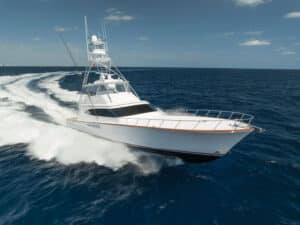
Special delivery: Sign up for the free Marlin email newsletter. Subscribe to Marlin magazine and get a year of highly collectible, keepsake editions – plus access to the digital edition and archives.
Capt. Peter B. Wright sure loved his tuna towers. In fact, he loved riding in the tower and writing about towers—most of the time about what was missing in terms of comfort and accessibility. But Wright backed it up by driving his boat from the tower as much as possible, as most all captains do in Australia. They fish from the tower for a lot of reasons, from looking for tailers to guessing the size of a marlin in the spread to navigating around the Great Barrier Reef and trying to avoid the many coral heads in the shallow water. On the reef, a good tower is more of a necessity than an accessory.
The first purpose-built tuna towers were designed for chasing the giant bluefins off Cat Cay and Bimini in the Bahamas, and naturally, Wright loved fishing for these giants from the tower too. Then, in more recent years, most all boats have towers because most people say the lines look better with one, and some others say the resale value is greater.
When I was fishing tournaments up in the Northeast, I saw quite a few boats without towers, probably because they really aren’t needed when you’re running out to the canyons and trolling all day. Those guys are usually not doing a whole lot of sight-fishing, if any at all. It’s also less money to put out for a charter boat.
Today there are a ton of different choices, from just a hardtop to a marlin tower and then to the iconic tuna tower; now we have the sky-bridge sport-fishing boats, with a convertible-style helm on top of an enclosed bridge. Even with outboards, you have a few choices too, with walk-through setups to stand on top of the console, all the way to full gap towers, just like the bigger boats.
During the Bahamas tournaments in the past few years, I have seen a lot more captains driving the boats from the tower, while others have a crewman stationed up there scanning the spread and hoping to help the anglers get the jump on a billfish bite. Having the additional height really helps, but it’s not too comfortable getting banged around when it’s bumpy offshore. Those tower spotters earn their pay in rough weather, and a Seakeeper can help keep things steady as well.
Read Next: Here’s a brief excerpt from Smith’s book, Tales of a Madam and Her Hooker.
I have no idea how these captains in the tower can watch the sonar, the chart plotter, the baits and the teasers, and then safely navigate around the other boats in the tournament or in the areas where they are fishing. Plus, they have to operate the teasers when they do raise a fish—it’s a busy little office to have up there on top of the boat, that’s for sure.
Back when I was record fishing, we did not have teaser reels in the tower; otherwise, I would have loved to have spent more time up there. Instead, I needed to be on the bridge, ready to tease up the billfish while each of my deckhands manned a teaser rod. Then, once we were hooked up, it was easier to drive on the fish from the bridge too. And I thought it was chaotic back then!







